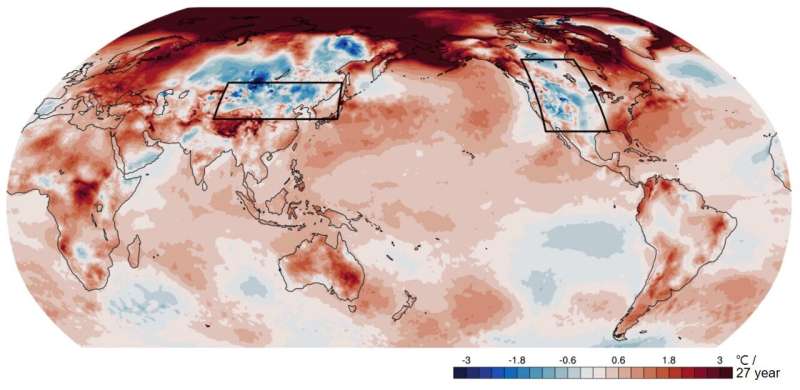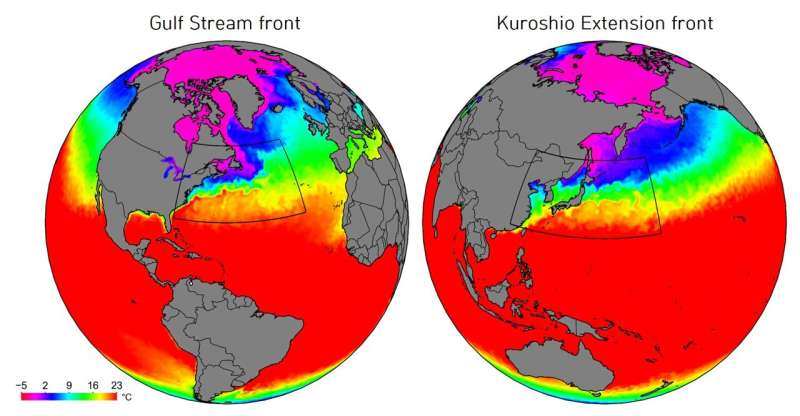This article has been reviewed according to Science X's editorial process and policies. Editors have highlighted the following attributes while ensuring the content's credibility:
fact-checked
peer-reviewed publication
trusted source
proofread
Research traces cause of recent cold waves over East Asia and North America to mid-latitude ocean fronts

If the world is warming, why are our winters getting colder? Indeed, East Asia and North America have experienced frequent extreme weather events since the 2000s that defy average climate change projections. Many experts have blamed Arctic warming and a weakening jet stream due to declining Arctic sea ice, but climate model experiments have not adequately demonstrated their validity.
The massive power outage in Texas in February 2021 was caused by an unusual cold snap, and climate models are needed to accurately predict the risk of extreme weather events in order to prevent massive socioeconomic damage. In particular, climate technology leaders have recently set the ability to predict the climate of the next decade or so as an important goal.
The Korea Institute of Science and Technology (KIST) has announced that senior researcher Mi-Kyung Sung of the Sustainable Environment Research Center and professor Soon-Il An of the Center for Irreversible Climate Change at Yonsei University have jointly discovered the role of mid-latitude oceans as a source of anomalous waves that are particularly frequent in East Asia and North America, paving the way for a mid- to long-term response to winter climate change.
The work is published in the journal Nature Communications.
Ocean currents have a major impact on the weather and climate of neighboring countries as they transport not only suspended and dissolved matter but also heat energy. In particular, regions where temperatures change rapidly in a narrow latitudinal band, such as the Gulf Stream in the Atlantic Ocean and the downstream region of the Kuroshio Current in the Pacific Ocean, are called "ocean fronts," and the KIST-Yonsei joint research team attributes the atmospheric wave response to the excessive accumulation of heat in these ocean fronts as the cause of the increase in extreme cold waves.
From the early 2000s until recently, anomalous cold trend in East Asia coincided with the accumulation of heat near the Gulf Stream in the North Atlantic, and that in North America coincided with the intensification of heat accumulation near the Kuroshio Current. The oceanic frontal region acts as a thermostat to control the frequency of winter cold waves and anomalous high temperatures.
The process of heat accumulation in oceanic frontal regions lasts from years to decades. During this time, a warming hiatus can occur in the continental regions that bucks the global warming trend. Conversely, during decades of ocean frontal cooling, continental regions appear to experience a sharp acceleration of warming.

This suggests that the recent decadal cooling trend is essentially reinforced by temporary natural variability in the global climate system, and that we can expect unseasonably warm winter weather to become more prevalent as the heat buildup in the ocean front is relieved.
These results are also evident in climate model experiments that vary the amount of heat accumulation near ocean fronts, showing that observations and climate model experiments are consistent in their conclusions, in contrast to conventional sea ice theory.
This highlights the importance of accurately simulating ocean front variability in climate models to improve our ability to predict medium- and long-term climate change over the next decade.
As global warming intensifies in the future and changes the structure of the ocean, these regional climate variations could change dramatically.
Climate model experiments with increased greenhouse gases have shown that North America is likely to experience shorter and fewer warming hiatus, while East Asia is likely to experience more frequent intersections between warming hiatus and acceleration. These different continental responses are driven by the different oceanic responses of the Kuroshio Current and the Gulf Stream to global warming.
"Applying the effects of ocean fronts revealed in this research to global warming climate models can improve climate change forecasts for the near future," said Dr. Mi-Kyung Sung of KIST.
"It will provide important references for long-term forecasts of winter energy demand and the construction of climate change response infrastructure to prevent climate disasters such as the 2021 Texas power outage."
More information: Mi-Kyung Sung et al, Ocean fronts as decadal thermostats modulating continental warming hiatus, Nature Communications (2023). DOI: 10.1038/s41467-023-43686-1
Journal information: Nature Communications





















